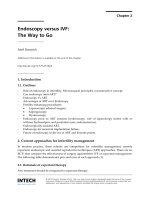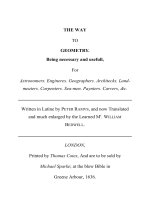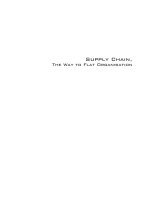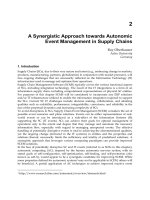ielts cube the way to study
Bạn đang xem bản rút gọn của tài liệu. Xem và tải ngay bản đầy đủ của tài liệu tại đây (947.27 KB, 20 trang )
1
IELTS CUBE
The Way to Study
IELTS
By
Glenn CAVULDAR
2
IELTS
Academic
Listening
3
An Overview of IELTS Listening
Module format
IELTS Listening has four sections, each with 10 items (or questions). Each item is worth one mark.
The items are designed so that the answers appear in order in the listening passage. During the test,
time is given for candidates to read the questions and write down and check their answers. Answers
are written on the Question Paper as candidates listen. When the tape ends, ten minutes are
allowed for candidates to transfer their answers onto an Answer Sheet.
The table below provides a summary of IELTS Listening.
SECTION
Topic
Area
Input Main Skill Focus
Number
of
Questions
1
Social
needs
Conversation with a
transactional purpose e.g.
finding out about travel
services
Listening for and noting
specific factual information
10
2
Social
needs
Monologue or prompted
monologue with a
transactional purpose e.g.
giving information about a
public event
Listening for and noting
specific factual information
10
3
Education
and
training
Discussion between 2 – 4
people in an academic
context, e.g. tutorial or
seminar
Following a conversation
which involves negotiation of
meaning. Listening for
specific information,
attitudes, and speakers'
opinions
10
4
Education
and
training
Monologue in an academic
context e.g. lecture
Following an academic
argument. Listening for main
ideas, specific information,
attitude and speaker's opinion
10
Answer format
Candidates write their answers on an answer sheet.
Timing
Approximately 30 minutes plus 10 minutes transfer time.
Marks
Each question carries one mark, giving a total of 40 marks.
Listening texts
The first two sections are concerned with social needs. There is a dialogue between two speakers,
for example a conversation about travel arrangements, and then a monologue, for example a
recording about museum opening times.
The final two sections are concerned with situations related more closely to educational or training
contexts. There is a conversation between up to four people, for example a conversation between a
tutor and a student about an assignment, and then a further monologue, for example a lecture of
general academic interest.
4
Task types
A variety of task types is used. The principal task types are:
Task Type 1 Forms/Notes/Table/Flow-chart/Summary Completion
Task Type 2 Multiple Choice
Task Type 3 Short-answer Questions
Task Type 4 Sentence Completion
Task Type 5 Labelling a Diagram/Plan/Map
Task Type 6 Classification
Task Type 7 Matching
Recordings
Each section is played ONCE only. The recordings include a range of accents, including British,
Australian, New Zealand and American.
IELTS Listening – Task Type 1 – Form/Notes/Table/Flow-chart/Summary Completion
Task Description
What are candidates required to do?
Candidates have to fill in gaps in an outline of part or of all of the listening text. The outline will
focus on the main ideas in the text.
In all cases except the summary, note form can be used when completing the gaps. This means that
articles, auxiliary verbs etc. may be omitted when they are not necessary for the meaning. The
summary is written in connected sentences and so it must be grammatically correct.
What variations are there on this task type?
The outline may be
1. a form: often used to record factual details such as names.
2. a set of notes: used to summarise any type of information using the layout to show how
different items relate to one another.
3. a table: used as a way of summarising information which relates to clear categories – e.g.
place/time/price.
4. a flow-chart: used to summarise a process which has clear stages. The direction of the
process is shown by arrows.
5. a summary: used to summarise any information in the form of a complete text.
Candidates may have to
• select their answers from a list on the Question Paper.
• identify the missing words from the recording which fit into the form/notes etc. In this
case, they should not change the words from the recording in any way, and should keep to
the word limit stated in the instructions.
How many words or numbers can be used to fill the gaps?
Candidates should read the instructions very carefully as the number of words or numbers they
should use to fill the gaps will vary.
5
Understanding the Task
Examples of Task Type 1 – Completion of Form, Notes, Table, Flow-Chart or Summary
Things to consider
Now look at these questions about how you approached the task and consider your answers.
1. Do the notes form a record of the main points in the conversation?
2. What is the maximum number of words / letters you can write for each answer?
3. Can an answer consist of just one word?
4. Where there is a measurement, as in Questions 4 and 5, is it necessary to write the unit
(e.g. metres, centimetres)?
5. What should be copied onto the Answer Sheet?
Example 1
–
summary completion with a list of answers to choose from
Complete the summary below using words from the box.
earthquakes
farms
floods
fruit
jungle
mountains
rice
towns
villages
The island consists of a coastal plain with 1 in the North. There are many 2
on the coastal plain, where 3 is grown. However, this region also
suffers from occasional 4 The capital city was originally in the North, but it was
completely destroyed by 5 in the nineteenth century.
Example 2 – table completion
Complete the table below.
Write NO MORE THAN THREE WORDS AND/OR A NUMBER for each answer.
Activity People involved Time spent per week
Problems
Cooking 1 15 hours lack of 2
Cleaning Sue and Steve 3 no electricity
4 Alanis 6 hours 5
6
IELTS Listening – Task Type 2 – Multiple Choice
Task Description
What are candidates required to do?
There is a question or a sentence beginning followed by three possible answers or sentence endings.
Candidates have to choose the one correct answer A, B or C.
What form do the questions take?
They may involve sentence completion – the stem gives the first part of a sentence and candidates
choose the best way to complete it from the options. The stem could also be worded as a complete
question, with the candidates choosing the option which best answers it.
What variations are there on this task type?
Sometimes candidates are given a longer list of possible answers and told that they have to choose
more than one. In this case they should read the question carefully to check how many answers are
required.
What skills are being tested?
Multiple Choice items are used to test a wide range of skills. They may require the candidate to
have a detailed understanding of specific points or an overall understanding of the main points of
the listening text.
Understanding the Task
Examples of Task Type 2 – Multiple Choice
Example 1 – where there is one answer
Choose the correct letter, A, B or C.
1 Paul and Jill decide to travel by
A taxi.
B bus.
C train.
Example 2
–
where there is more than one answer
Choose TWO letters A-E.
1 Which TWO hotel facilities are inspected?
A bathrooms
B bedrooms
C dining-room
D
kitchen
E reception
7
Things to consider
Now look at these questions about how you approached the task and consider your answers.
1. What type of listening skill is being tested here?
2. How many letters can you choose for each question?
3. Does it matter how you mark your answer on the Question Paper?
4. In which question, 9 or 10, does the correct answer come just from the customer?
5. In which question, 9 or 10, do you need to combine information given by the agent and the
customer to get the right answer?
6. Are the words in the recording the same as the words on the Question Paper?
IELTS Listening – Task Type 3 – Short-answer Questions
Task Description
What are candidates required to do?
Candidates read a question to which they have to write a short answer using information from the
listening text. A word limit is given, usually no more than three words and/or a number.
(Candidates should check this carefully for each task.)
What variations are there on this task type?
Sometimes candidates are given a question which asks them to list two or three points.
Are candidates penalised for writing more than the stated number of words?
Yes. If candidates write more than the number of words asked for, they will lose the mark even if
their answer includes the correct word(s).
What about contractions or hyphenated words?
Contracted words will not be tested. Hyphenated words count as single words.
Understanding the Task
Example 1
Answer the questions below.
Write NO MORE THAN THREE WORDS AND/OR A NUMBER for each answer.
1
In which newspaper did Ahmed see the advertisement?
2
At what time did he arrive at the theatre?
8
Things to consider
Now look at these questions about how you approached the task and consider your answers.
1. What type of information do these questions focus on?
2. Do the answers have to be complete sentences?
3. Do the answers have to include words such as a/the?
4. What is the maximum number of words/letters/numbers you can write for each answer?
5. Can some of the answers consist of just one word?
6. Where the answer is a sum of money, is it necessary to write the currency symbol? (e.g.
£/$)
IELTS Listening – Task Type 4 – Sentence Completion
Task Description
What are candidates required to do?
Candidates read a set of sentences summarising key information from all the listening text or from
one part of it. They have to complete a gap in each sentence using information from the listening
text. They usually have to write no more than three words and/or a number.
How are candidates asked to write their answers?
The words should be taken directly from the listening text and written in the space on their
Question Paper to be transferred later.
Are candidates penalised for writing more than the stated number of words?
Yes. If candidates write more than the number of words asked for, they will lose the mark even if
their answer includes the correct word(s).
What about contractions, or hyphenated words?
The rules for Short-answer Questions also apply here. Contracted words will not be tested.
Hyphenated words count as single words.
Example 2
List THREE things which Carla wants to buy in the department store.
Write NO MORE THAN THREE WORDS for each answer.
1
2
3
9
Understanding the Task
Example of Task Type 4 – Sentence Completion
Things to consider
Now look at these questions about how you approached the task and consider your answers.
1. What type of information is summarised in these sentences?
2. How many words can you write for each answer?
3. Are the sentences on the Question Paper exactly the same as the sentences you hear in the
recording?
4. Do you have to write down the words in exactly the same form as you hear them?
5. Do the missing words have to be spelled correctly?
6. Should the completed sentences be grammatically correct?
IELTS Listening – Task Type 5 – Labelling a Diagram, Plan or Map
Task Description
What are candidates required to do?
Candidates have to complete labels on a visual. The answers are usually selected from a list on the
Question Paper. Candidates should transfer the letter of the option they have selected to the
Answer Sheet in the time allowed.
What variations are there on this activity?
The visual may be
• a diagram (e.g. a piece of equipment)
• a set of pictures
• a plan (e.g. of a building)
• a map (e.g. of part of a town)
Complete the sentences below.
Write NO MORE THAN THREE WORDS for each answer.
1
Hume was one of the first philosophers to question the
.
2
Hume’s philosophical works were particularly influential in
in the late 19th century.
10
Understanding the Task
Example of Task Type 5 – Labelling a Diagram, Plan or Map
Things to consider
Now look at these questions about how you approached the task and consider your answers.
1. What does the speaker tell you at the beginning of the talk to help you understand the plan?
2. Do the numbers of the labels on the plan follow the order of the recording?
3. Do you have to label every room?
4. Do you have to write whole words or just letters in the spaces?
5. Do you need to use all the places (A – I) you are given in the box?
6. What listening skill is this task type testing?
Task Description
What are candidates required to do?
Candidates have to match a numbered list of items from the listening text to a set of criteria.
What skills are being tested?
This task type is designed to test candidates’ ability to recognize relationships and connections
Example
–
Labelling a map
Label the map below.
Choose FOUR answers from the box and write the correct letter A-G next to questions 11-14.
A bank
B block of flats
C dentist
D flower shop
E garage
F Post Office
G school
11
between facts in the listening text, and is most often used with texts dealing with factual
information. Candidates need to be able to listen for detail.
Understanding the Task
Things to consider
Now look at these questions about how you approached the task and consider your answers.
1. Did the questions focus on details of the courses, or the speaker's attitudes to them?
2. Did you have to listen for paraphrases of the three categories given (A – C)?
3. Could you use the same answer more than once?
4. Did the information needed for the answers come just from one speaker, or from both?
IELTS Listening – Task Type 7 – Matching
Task Description
What are candidates required to do?
Candidates have to match a numbered list of items from the listening text to a set of items in a box.
What variations are there in this task type?
Many variations of this task type are possible as far as the type of options to be matched are
concerned.
Example
of Task Type 6
–
Classification
When did the following take place?
A in the early 17th century
B in the late 17th century
C in the early 18th century
Write the correct letter,
A, B,
or
C
next to questions 1
-
4.
1 increases in unemployment
2 mass migrations
3 educational reforms
4 frequent changes of government
12
Understanding the Task
Example of Task Type 7 – Matching
Things to consider
Now look at these questions about how you approached the task and consider your answers.
1. What type of information did this task type focus on?
2. Were the hotels described in the same order as they are listed?
3. Did you have to listen for paraphrases of the descriptions?
4. What type of listening skill is being tested?
What does the lecturer say about each book?
Choose your answers from the box and write the correct letter A-H next to questions 1-4.
A confusing
B detailed
C expensive
D good exam preparation
E needs updating
F oversimplified
G useful problems
H well illustrated
1 Basics in Economics (Bryson & Spark)
2 An Introduction to Economic Analysis (Kettle)
3 Economics in Action (Fodor)
4 Economics Today (Smith & Wyler)
13
DOs and DON'Ts
Listen carefully to the introduction to each section. This will give you useful
information about the situation and the speakers.
Use the time at the beginning of each section (and in the middle of Sections 1
– 3) to look through the questions and think about the topic.
Read the instructions for each task carefully. Remember to check the
maximum number of words allowed.
Write all your answers as you listen – remember you won’t hear the recording
a second time.
Check that what you write makes sense in the context.
Answer all the questions even if you don’t feel sure about an answer – you may
have understood more than you think.
Wait until the end of the test to transfer your answers. You have ten minutes
for this which is plenty of time.
Write clearly when you transfer your answers. If an answer isn’t clear on your
answer sheet, you will lose the mark.
Check your spelling (and grammar where necessary).
Don't worry if you have to cross out or change an answer.
Don't panic if you miss one question. Look ahead and concentrate on the next
one.
Don't try to rephrase what you hear. Write down the words you hear which fit
the question.
Don’t write more than the maximum number of words or letters allowed for
each answer.
Don’t copy any words that were printed on the Question Paper when you
transfer your answers to the Answer Sheet.
14
Developing General and Academic Listening Skills
Expectations of students at IELTS level
IELTS Listening is taken by both General Training and Academic candidates and is designed to cover
the full range of ability from non-user to expert user. It covers the basic survival skills in a broad
social and educational context, as well as the skills required for academic purposes.
How we listen in our own language
Listening involves both linguistic and non-linguistic knowledge. Linguistic knowledge includes
understanding of lexis, grammar, phonology and discourse. Non-linguistic knowledge may include
understanding of the context or situation, the topic and the purpose of the interaction. When we
listen in our first language we apply both types of knowledge at the same time to make sense of
what we hear. We can use our existing knowledge to predict what might come next, and check each
prediction in the light of the information we receive.
By using these skills, we can make sense of input in which individual sounds may be unclear, either
because of background noise or because they are affected by other sounds in the stream of speech.
We can also understand the meaning carried by stress and intonation, and we can hold pieces of
information in our short-term memory long enough to relate it to further information given later on.
In addition, we are able to interpret not just the surface meaning of the information conveyed but
the underlying attitudes and opinions.
Developing listening skills in a foreign language
Students may develop listening skills in the classroom through listening to and interacting with the
teacher and other students. In this case the context and purpose of the interaction is usually clear,
and the student can let the speaker know if he or she has not understood what was said.
Listening skills are also developed more formally through listening to recorded materials via a
variety of media. In this case the context and purpose may not be apparent, so students may need
to be provided with this information before they start listening. Specific listening tasks are usually
given in order to focus the students. Such tasks are likely to involve a degree of reading and writing.
Outside the classroom there is an increasing number of opportunities for students of English to
listen to different varieties of English through leisure and educational activities on video and TV,
through songs or computer and internet activities, as well as through interaction with other
speakers of English.
The difference between general and academic spoken English
IELTS Listening tests understanding of both general English in transactional situations, such as
making arrangements for transport, accommodation and leisure activities, and academic situations,
such as taking part in a seminar or listening to a lecture. In addition, candidates listen to both
conversations and monologues. In each case the context, purpose and relationship between
speakers will affect the language used.
• IELTS Listening Section 1 (conversation with a transactional purpose)
The conversation may be between two friends. In this case the speakers may use fillers,
phrasal verbs and colloquial expressions, they may leave sentences unfinished or interrupt
one another. If the conversation is between two people who do not know one another well
(e.g. a conversation between a shopkeeper and customer) the language is likely to be more
formal with phrases typical of this type of interaction (e.g. ‘What I was hoping is that you
could give me some sort of a refund.’)
• IELTS Listening Section 2 (monologue with a transactional purpose) The speaker may be
addressing the listeners directly – e.g. a speech by a tour guide. In this case, the language
may be quite informal. Alternatively, this section may present information in the form of a
recorded message or a radio broadcast directed at an unseen audience. In this case the
language may be more formal and with longer sentences and more complex syntax.
15
• IELTS Listening Section 3 (conversation in an academic context)
The conversation may display similar features of speech to those in Section 1, depending on
the relationship between the speakers, but the lexis and structures are likely to reflect
those more often heard in an academic context. The range of vocabulary is likely to be
wider than that of Section 1 conversations, and there is likely to be more negotiation of
meaning.
• IELTS Listening Section 4 (monologue in an academic context)
A monologue in an academic context is likely to have been carefully prepared and the
speaker may be referring to notes as he/she gives the talk or lecture. This section is likely
to be the closest to written language, with dense information and complex sentences with
subordinate clauses. However, the speaker will also usually use signposting language to help
the listener follow the argument.
IELTS Preparation – Teaching or Testing?
Teachers can train and support their students in IELTS preparation classes by
• selecting listening tasks on topics related to the students' knowledge and interests
• providing activities to remind students of what they already know about the topic and the
related language before they listen
• making sure that students are quite clear about what they have to do for each task type,
and the type of listening required
• pausing the tape or replaying when necessary in practice activities
• allowing plenty of time for checking and discussion of answers, and giving students access to
tapescripts at this stage
• providing additional opportunities for listening in a range of non-exam formats – e.g. songs,
videos, news broadcasts, real-life speakers – with tasks aimed at developing confidence and
motivation
16
General and Academic English - Worksheet
Look at each of the extracts below and decide which section of IELTS Listening it could come from,
and what features of the language or content helped you to make your decision. (You may be able
to justify more than one answer.)
Section 1 Section 2 Section 3 Section 4
1. that’d be great
2. Good evening, and welcome to
3.
The port’d be fine – I’ve got
transport that end.
4.
We begin our series of lectures on
5.
I’ve never learnt how to organise
my work
6. Finally, I would suggest that
7.
they left a wealth of evidence of
their civilisation.
8.
These seem to have been replaced
some time around or after 900
9.
I’m ringing to make enquiries
about …
10.
So I'm going to talk first about
11.
I’m glad I’ve bumped into you.
12.
Various theories attribute the
decline of …
13.
But first can you tell me, you
know, very generally …
14.
Yes, there’s … there's also some
toys.
15.
I found I needed to maintain a high
level of motivation,
16.
My other suggestion is that
17.
Oh I’ve been stung before with
economy insurance
18.
I’ve been asked to talk to you
briefly about
19.
What makes it easier is that the
degree is made up of modules
20.
the prehistoric cultures of the
American south-west
17
IELTS
Academic
Reading
18
IELTS Academic Reading
An Overview of IELTS Academic Reading
Module format
IELTS Academic Reading has 3 passages and 40 items (questions). The number of items for any one
passage may vary. Each item is worth one mark.
The texts and items appear in Question Booklets.
Answer format
Candidates record their responses on Answer Sheets.
Timing
IELTS Academic Reading takes 60 minutes to complete. Candidates are not given extra time to
transfer their answers onto the Answer Sheet. They should do this as they work through the test.
Marks
One mark is awarded for each correct answer.
Texts
The passages used in the test are based on authentic texts, and are taken from sources such as
magazines, journals, books and newspapers. They are designed to present the candidate with
materials similar to those which they might need to read on a university course. Passages may also
contain non-verbal material such as diagrams, graphs, illustrations etc. The passages may be written
in a variety of styles, for example narrative, descriptive or discursive/argumentative. They deal
with issues which are interesting, recognisably appropriate, and accessible to candidates entering
postgraduate or undergraduate courses or seeking professional registration. At least one of the
passages will contain detailed argument.
Length
The total word count for the three passages is between 2000 and 2750 words.
Task Types
There are 10 basic task types, some with possible variations. They are:
Task Type 1 Multiple Choice
Task Type 2 Short-answer Questions
Task Type 3 Sentence Completion
Task Type 4 Notes, Summary or Table/Flow-chart Completion
Task Type 5 Labelling a Diagram
Task Type 6 Choosing Headings for Paragraphs or Sections of a Text
Task Type 7 Locating Information
Task Type 8 Identification of Writer’s Views/Claims or of Information in a Text
Task Type 9 Classification
Task Type 10 Matching
19
Academic Reading Skills and Strategies in IELTS
What reading skills are tested in IELTS Academic Reading?
This is a test of reading comprehension in a general academic context. The texts used and the skills
tested are intended to reflect the target language needs of undergraduate and postgraduate
students, without bias for or against students of any particular discipline. Candidates may have to:
• identify the writer’s overall purpose, target audience, sources etc.
• identify and follow key arguments in a text
• identify opinions and attitudes as opposed to facts
• locate specific information
• read for detailed information
• extract relevant information
• distinguish the main idea from supporting detail
• recognise key points for a summary
• group pieces of information in a text in accordance with salient criteria
• extract information from a prose text to put into a diagrammatic representation
• make inferences
• use correct spelling and correct grammar in their answers
How do we read text?
In everyday life we use different strategies or approaches to read different texts. Sometimes we
read quickly, skimming for general ideas or scanning for a specific point. Sometimes we read slowly,
trying to gain a detailed understanding. How we read depends on the text – its length, its type – and
our purpose in reading it.
What is skimming?
When we skim a text we read very quickly. We just look at the headings and subheadings and the
first lines of each section or paragraph. We also notice the key words that are repeated throughout
the text. Our purpose is to understand the gist – the general idea of the text. Skimming is a useful
strategy to use throughout IELTS Academic Reading.
What is scanning?
When we scan a text we are looking for a specific piece of information or specific words. We ignore
information that is not relevant to our purpose. Scanning is a useful strategy to apply when the
questions ask for specific factual information. It is also a useful strategy to use to find the section of
a text about which a question is asked.
What is reading for detail?
When we read for detail we read every word in a text and think carefully about the meaning of
every sentence. It is often necessary in IELTS Academic Reading to read a certain section of a text
in detail in order to answer a question correctly. Usually a candidate must skim or scan the text
first to find the right section and then, having found the relevant section, read for detail.
IELTS Academic Reading – Task Type 1 – Multiple Choice
Task Description
What are candidates required to do?
Candidates are asked to choose the best answer from four alternatives A, B, C or D, and to write the
letter of the answer they have chosen on the Answer Sheet.
What form do the questions take?
They may involve sentence completion – the stem gives the first part of a sentence and candidates
choose the best way to complete it from the options. The stem could also be worded as a complete
question, with the candidates choosing the option which best answers it.









